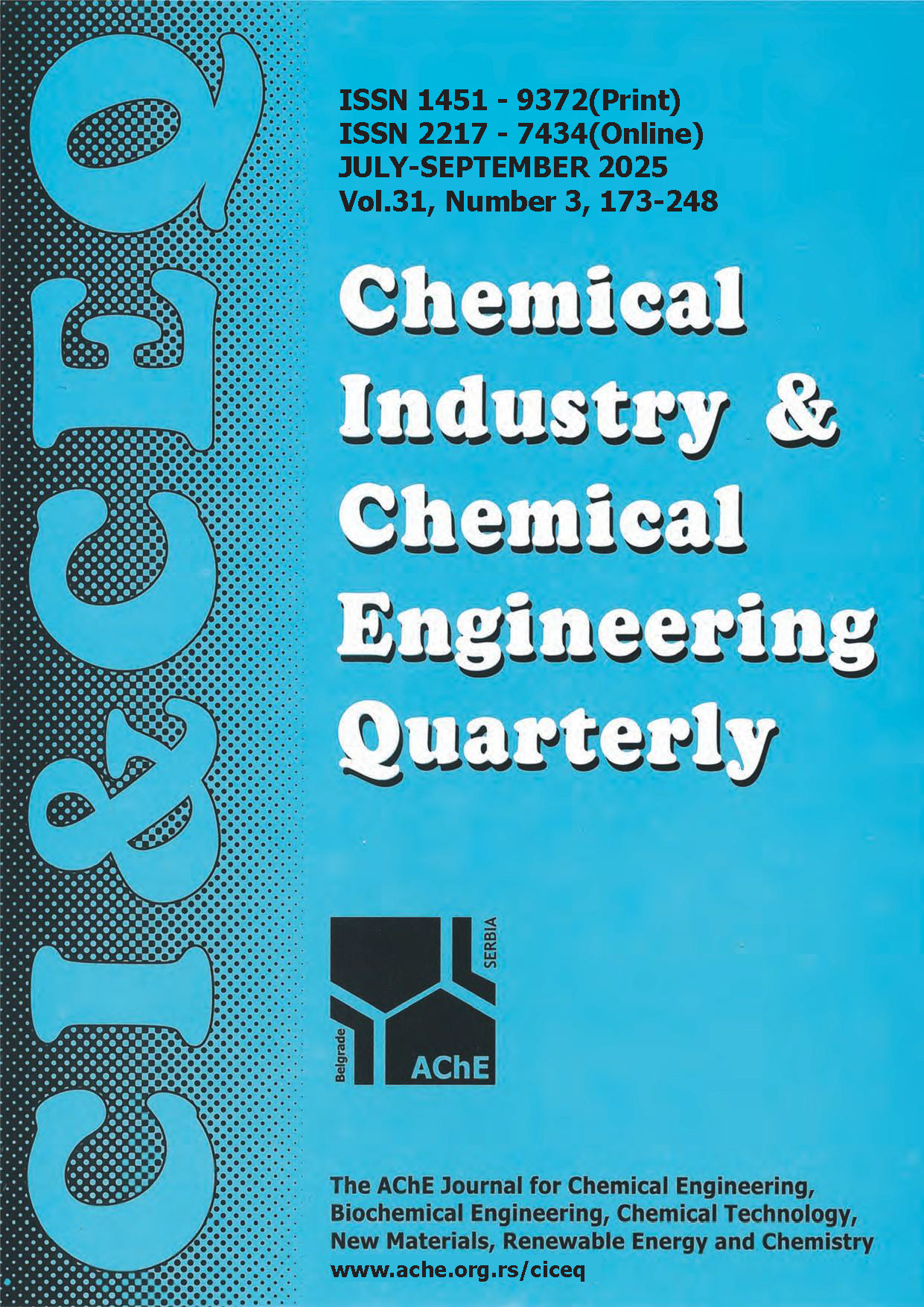SUPPRESSING PRE-HYDROLYSIS IN TiO2 MANUFACTURING: DESIGN OPTIMIZATION OF AN INDIRECT HEATING HYDROLYSIS SYSTEM
Original scientific paper
DOI:
https://doi.org/10.2298/CICEQ230731031HKeywords:
Multiphase, conjugate CFD simulation, precipitation, particle size distribution, TiO2 manufacturing, indirect heating hydrolysisAbstract
The particle size of 〖TiO〗_2 is critically influenced by the operation of the hydrolysis process. Failure to achieve uniform particle size during hydrolysis can have significant repercussions on subsequent processes, such as washing, reduction, and bleaching procedures, ultimately leading to the production of unusable final products. The primary goal of this study is to suppress pre-hydrolysis, which is a factor that impedes the formation of uniform particles during the hydrolysis procedure. To overcome this issue, the researchers designed an indirect heating system to mitigate the pre-hydrolysis phenomenon. For designing an indirect heating system, multiphase Computational Fluid Dynamics (CFD) simulations were performed. The proposed optimized design was then implemented and tested in the actual field. The success of the field test was evaluated through settling value tests conducted on the hydrolyzed solution, and the uniformity of particle size was analyzed using Transmission Electron Microscopy (TEM) images, Scanning Electron Microscope (SEM), and Microtrac. The findings of this study demonstrate the effective application of the developed multiphase CFD simulation in enhancing the hydrolysis process for the production of anatase titanium dioxide particles. This successful integration demonstrates the application of mechanical engineering techniques in the field of chemical engineering.
References
[1] X. Xiong, Z. Wang, F. Wu, X. Li, H. Guo, Adv. Powder Technol. 24 (2013) 60—67. https://doi.org/10.1016/j.apt.2012.02.002.
[2] K.H. Cheung, M.B. Pabbruwe, W.F. Chen, Ceram. Int. 47 (2021) 1609—1624. https://doi.org/10.1016/j.ceramint.2020.08.277.
[3] B. Grzmil, D. Grela, B. Kic, Pol. J. Chem. Technol. 11 (2009) 15—21. https://doi.org/10.2478/v10026-009-0030-1.
[4] K.D. Кim, S.H. Kim, H. Тaik, Colloids Surf., A 254 (2005) 99—105. https://doi.org/10.1016/j.colsurfa.2004.11.033.
[5] E.A. Moskalenko, A.A. Sadovnikov, A.E. Baranchikov, A.E. Goldt, V.V. Kozik, V.K. lvanov, Curr. Microwave Chem. 1 (2014) 81—86. https://doi.org/10.2174/2213335601666140404163607.
[6] M. Danish, S. Ambreen, A. Chauhan, A. Pandey, J. Saudi Chem. Soc. 19 (2015) 557—562. https://doi.org/10.1016/j.jscs.2015.05.010.
[7] Y. Bessekhouad, D. Robert, J.V. Weber, J. Photochem. Photobiol., A 157 (2003) 47—53. https://doi.org/10.1016/S1010-6030(03)00077-7.
[8] J.H. Han, H.J. Kim, D.H Lee, J. Enhanced Heat Transfer 30 (2023) 1—20. http://doi.org/10.1615/JEnhHeatTransf.2023047657.
[9] E.A. Barringer, H.K. Bowen, Am. Chem. Soc. 1 (1985) 420—428. https://doi.org/10.1021/la00064a005.
[10] S. Mahshid, M. Askari, M.S. Ghamsari, J. Mater. Process. Technol. 189 (2007) 296—300. https://doi.o rg/10.1016/j.jmatprotec.2007.01.040.
[11] Q. Zhang, L. Gao, J. Guo, J. Eur. Ceram. Soc. 20 (2000) 2153—2158. https://doi.org/10.1016/S0955-2219(00)00085-6.
[12] N. Shijie, L. Debao, L. Yunshi, Y. Ping, J. Nanosci. Nanotechnol. 17 (2017) 3430—3434. https://doi.org/10.1166/jnn.2017.12808.
[13] D.C.M. Dutoit, M. Schneider, R. Hutter, A. Baiker, J. Catal. 161 (1996) 651—658. https://doi.org/10.1006/jcat.1996.0227.
[14] U. Gesenhues, Chem. Eng. Technol. 26 (2003) 25—33. https://doi.org/10.1002/ceat.200390001.
[15] J. Olabarrieta, O. Monzon, Y. Belaustegui, J. Inaki, S. Zorita, Sci. Total Environ. 618 (2018) 551—560. https://doi.org/10.1016/j.scitotenv.2017.11.003.
[16] I. Plazl, S. Leskovsek, T. Koloini, Chem. Eng J. 59 (1995) 253—257. https://doi.org/10.1016/0923-0467(94)02953-9.
[17] J.B. Joshi, N.K. Nere, C.V. Rane, B.N. Murthy, C.S. Mathpati, A.W. Patwardhan, V.V Ranade, Can. J. Chem. Eng. 89 (2011) 754—816. https://doi.org/10.1002/cjce.20446.
[18] H. Patil, A.K. Patel, H.J. Pant, A.V. Vinod, Hydraul. Eng. 27 (2021) 200—209. https://doi.org/10.1080/09715010.2018.1535921.
[19] F. Chen, W. Zhong, D. Wan, Ocean. Eng. 257 (2022) 1—13. https://doi.org/10.1016/j.oceaneng.2022.111525.
[20] R. Steijl, G. Barakos, Int. J. Numer. Methods Fluids 58 (2008) 527—549. https://doi.org/10.1002/fld.1757.
[21] J. Mcnaughton, I. Afgan, D.D. Apsley, Int. J. Numer. Methods Fluids 74 (2013) 250—269. https://doi.org/10.1002/fld.3849.
[22] G. Desquesnes, M. Terracol, E. Manoha, P. Sagaut, J. Comput. Phys. 220 (2006) 355—382. https://doi.org/10.1016/j.jcp.2006.05.019.
[23] H. Orihara, H. Miyata, J. Mar. Sci. 8 (2003) 47—60. https://doi.org/10.1007/s00773-003-0163-5.
[24] Y. Guo, C.Y. Wu, C. Thornton, AIChE J. 59 (2013) 1059—1087. https://doi.org/10.1002/aic.13900.
[25] P. Zhao, J. Xu, X. Liu, W. Ge, J. Wang, Phys. Fluids 32 (2020) 1—12. https://doi.org/10.1063/5.0023423.
[26] S.H. Saraei, B. Peters, Powder Technol. 426 (2023) 118—125. https://doi.org/10.1016/j.powtec.2023.118603.
[27] J. Wang, H. Liu, D. Xu, Z. Chen, K. Ma, Build. Sci. 160 (2019) 106—122. https://doi.org/10.1016/j.buildenv.2019.106208.
[28] R. Mitkov, M. Pantusheva, V. Naserentin, P. Hristov, A. Logg, IFAC Proc. Ser. 55 (2022) 179—184. https://doi.org/10.1016/j.ifacol.2022.08.069.
Downloads
Published
Issue
Section
License
Copyright (c) 2023 Junhee Han, Hyojung Kim, Dohyung Lee

This work is licensed under a Creative Commons Attribution-NonCommercial-NoDerivatives 4.0 International License.
Authors who publish with this journal agree to the following terms:
Authors retain copyright and grant the journal right of first publication with the work simultaneously licensed under a Creative Commons Attribution License that allows others to share the work with an acknowledgement of the work's authorship and initial publication in this journal.
Authors grant to the Publisher the following rights to the manuscript, including any supplemental material, and any parts, extracts or elements thereof:
- the right to reproduce and distribute the Manuscript in printed form, including print-on-demand;
- the right to produce prepublications, reprints, and special editions of the Manuscript;
- the right to translate the Manuscript into other languages;
- the right to reproduce the Manuscript using photomechanical or similar means including, but not limited to photocopy, and the right to distribute these reproductions;
- the right to reproduce and distribute the Manuscript electronically or optically on any and all data carriers or storage media – especially in machine readable/digitalized form on data carriers such as hard drive, CD-Rom, DVD, Blu-ray Disc (BD), Mini-Disk, data tape – and the right to reproduce and distribute the Article via these data carriers;
- the right to store the Manuscript in databases, including online databases, and the right of transmission of the Manuscript in all technical systems and modes;
- the right to make the Manuscript available to the public or to closed user groups on individual demand, for use on monitors or other readers (including e-books), and in printable form for the user, either via the internet, other online services, or via internal or external networks.




